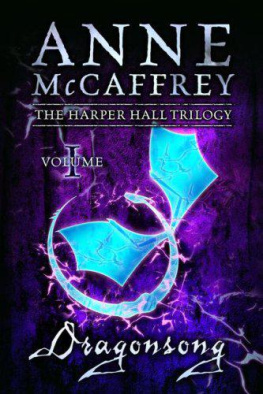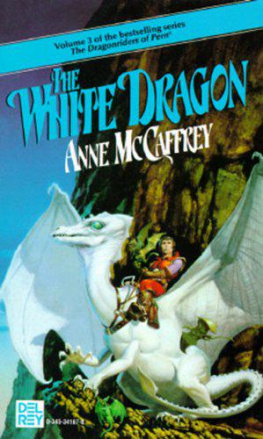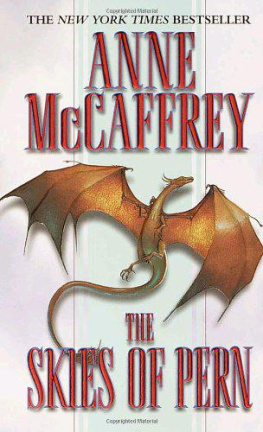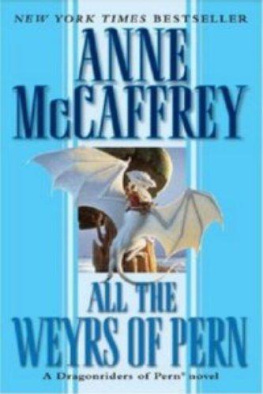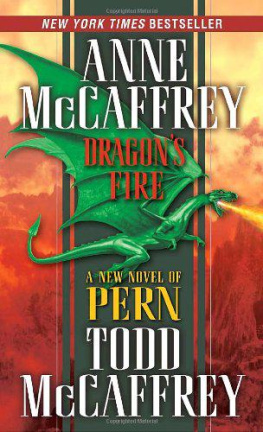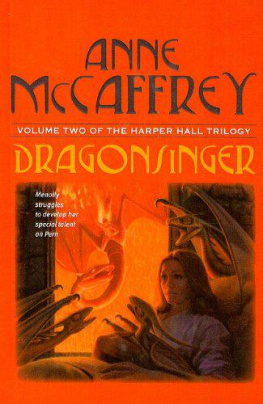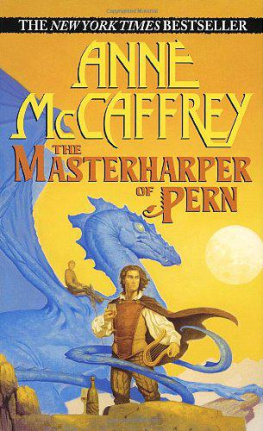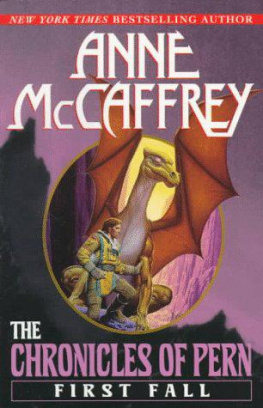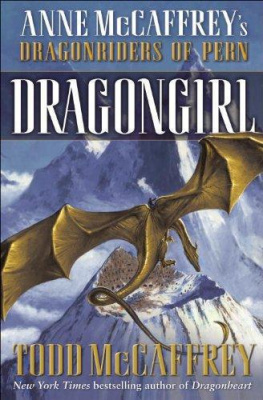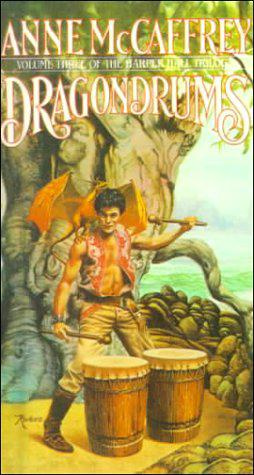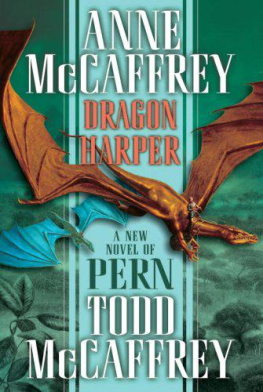DragonSong
by Anne McCaffrey
Foreword
Rukbat, in the Sagittarian Sector, was a golden G-type star. It had five planets, two asteroid belts, and a stray planet it haft attracted and held in recent millennia. When men first settled on Rukbaf s third world and called it Pern, they had taken little notice of the stranger planet, swinging about its adopted primary in a wildly erratic elliptical orbit. For two generations, the colonists gave the bright red star little thought, until the path of the wanderer brought it close to its stepsister at perihelion.
Then, the spore life, which proliferated at an incredible rate on the Red Star's wild surface, spun off into space and bridged the gap to Pern. The spores fell as thin threads on the temperate, hospitable planet, and devoured anything organic in their way, seeking to establish burrows in Pern's warm earth from which to set out more voracious Threads.
The colonists suffered staggering losses in terms of people scored to death, and in crops and vegetation wiped out completely. Only fire killed Thread on land: only stone and metal stopped its progress. Fortunately it drowned in water, but the colonists could scarcely live on the seas.
The resourceful men cannibalized their transport ships and, abandoning the open southern continent where they had touched down, set about making the natural caves in the northern continent habitable. They evolved a two-phase plan to combat Thread. The first phase involved breeding a highly specialized variety of a life-form indigenous to their new world. The "dragons" (named for the mythical Terran beast they resembled) had two extremely useful characteristics: they could get from one place to another instantly by tele-portation, and when they had chewed a phosphine-bearing rock, they could emit a flaming gas. Thus the flying dragons could char Thread to ash midair and escape its ravages themselves.
Men and women with high empathy ratings or some innate telepathic ability were trained to use and preserve these unusual animals, partnering them in a lifelong and intimate relationship.
The original cave-Fort, constructed in the eastern face of the great West Mountain range, soon became too small to hold either the colonists or the great "dragons." Another settlement was started slightly to the north, by a great lake, conveniently nestled near a cave-filled cliff. Ruatha Hold, too, became overcrowded in a few generations.
Since the Red Star rose in the East, it was decided to start a holding in the eastern mountains, provided suitable accommodations could be found. The ancient cave-pocked cones of extinct volcanoes in the Benden mountains proved so suitable to the dragonmen and women that they searched and found several more throughout Pern, and left Fort Hold and Ruatha Hold for the pastoral colonists, the holders.
However, such projects took the last of the fuel for the great stonecutters, originally thought to be used for the most diffident mining since Pern was light on metals, and any subsequent holds and weyrs were Hand-hewn.
The dragons and their riders in their weyrs, and the people in the cave holdings, went about their separate tasks and each developed habits that became custom, which solidified into tradition as incontrovertible as law.
By the Third Pass of the Red Star, a complicated so- cial, political and economic structure had developed to deal with the recurrent evil of Thread. There were now six Weyrs, pledged to protect all Pern, each Weyr having a geographical section of the northern continent literally under its wings. The rest of the population, the Holds, agreed to tithe to support the Weyrs, since these fighters, these dragonmen, did not have any arable land in their volcanic homes, nor did they have time for fanning while protecting the planet from Passes of the Thread.
Holds developed wherever natural caves could be found: some, of course, were extensive or strategically placed near good water and grazing, others were smaller and less well placed. It took a strong man to keep frantic, terrified people in control in the Holds during Thread attacks: it took wise administration to conserve food supplies for times when nothing could be safely grown. Extraordinary measures controlled population, keeping its number healthy and useful until such time as the Thread should pass. And often children from one Hold were raised in another Hold, to spread the generic pool and keep the Holds from dangerous inbreeding. Such a practice was called "fostering" and was used in both Hold and Crafthalls, where special skills such as metalworking, animal breeding, farming, fishing and mining (such as there was) were preserved. So that one Lord Holder could not deny the products of a Crafthall situated in his Hold to others, the Crafts were decreed independent of a Hold affiliation, each Craftsmaster at a hall owing allegiance only to the Master of that particular craft who, as the need arose, took likely students in as fosterlings.
Except for the return of the Red Star approximately every two hundred years, life was pleasant on Pern.
There came a time when the Red Star, due to the conjunction of Rukbar's five natural satellites, did not pass close enough to Pern to drop the dreadful spores. And the Pernese forgot about the danger. The people prospered, spreading out across the rich land, carving more Holds out of solid rock and becoming so busy with their pursuits, that they did not realize that there were only a few dragons hi the skies, and only one Weyr of dragonriders left on Pern. In a few generations, the descendants of the Holders began to wonder if the Red Star would ever return. The dragonriders fell into disfavor: why should all Pern support these people and their hungry beasts? The legends of past braveries, and the very reason for such courage, became dishonored.
But, in the natural course of events, the Red Star again spun close to Pern, winking with a baleful red eye on its intended victim. One man, FTar, rider of the bronze dragon, Mnementh, believed that the ancient tales had truth in them. His half brother, Fnor, rider of brown Canth, listened to his arguments and came to believe. When the last golden egg of a dying queen dragon lay hardening on the Benden Weyr Hatching Ground, Flar and Fnor seized the opportunity to gain control of the Weyr. Searching Ruatha Hold, they found a strong woman, Lessa, the only surviving member of the proud bloodline of Ruatha Hold. She impressed young Ramoth, the new queen, and became Weyrwoman of Benden Weyr. And Flares bronze Mnementh became the new queen's mate.
The three young riders, FTar, Fnor and Lessa forced the Lord Holders and the Craftsmen to recognize their imminent danger and prepare the almost defenseless planet against TTiread. But it was distressingly obvious that the scant two hundred dragons of Benden Weyr could not defend the wide-spread and sprawling settlements. Six full Weyrs had been needed in the olden days when the settled land had been much less extensive. In learning to direct her queen between one place and another, Lessa discovered that dragons could tele-port between times as well. Risking her life as well as Pern's only queen, Lessa and Ramoth went back in time, four hundred Turns, to the days before the mysterious disappearance of the other five Weyrs, just after the last Pass of the Red Star had been completed.
The five Weyrs, seeing only the decline of their prestige and bored with inactivity after a lifetime of exciting combat, agreed to help Lessa, and Pern, and came forward to her time.
Drdgonsong begins seven Turns after the Five Weyrs came forward.
_Chapter 1
Drummer, beat, and piper, blow Harper, strike, and soldier, go Free the flame and sear the grasses Tfl the dawning Red Star passes.
Almost as if the elements, too, mourned the death of the gentle old Harper, a southeaster blew for three days, locking even the burial barge in the safety of the Dock Cavern.
Next page
